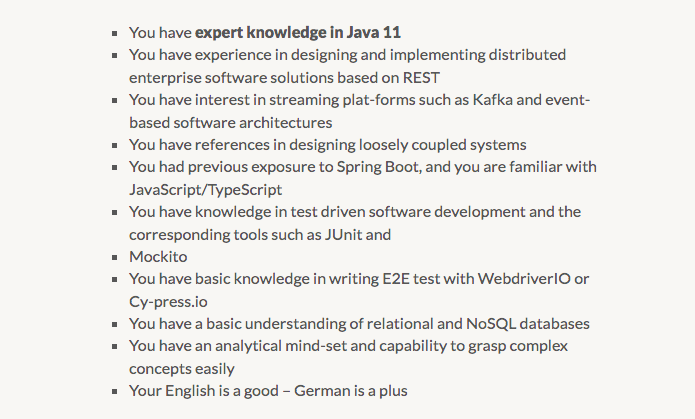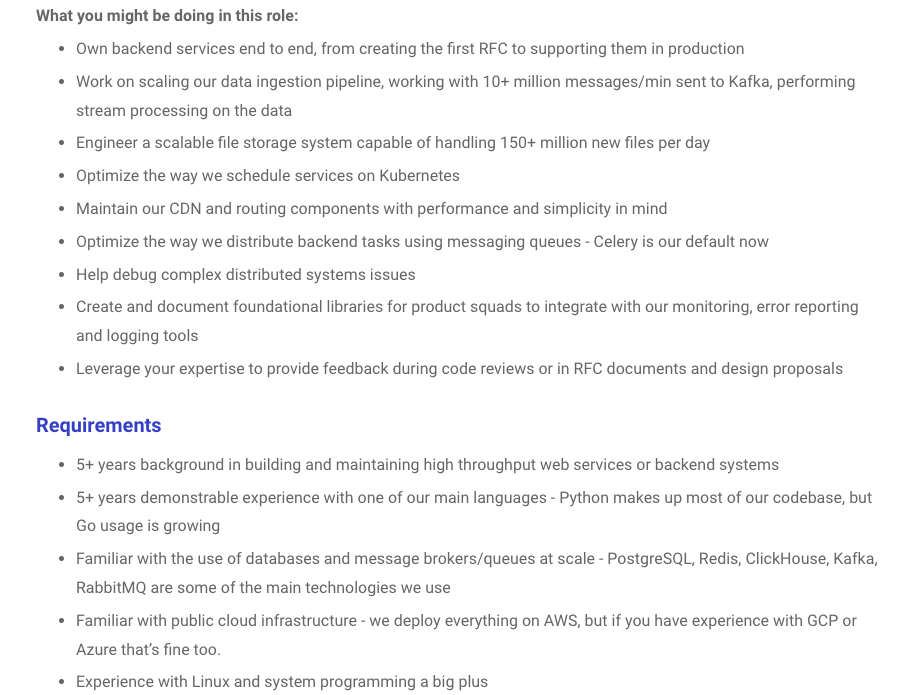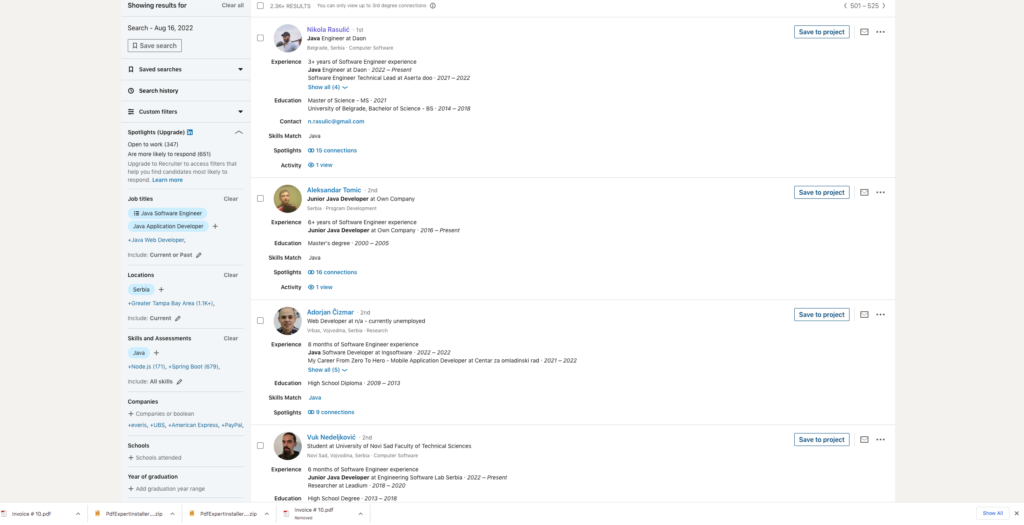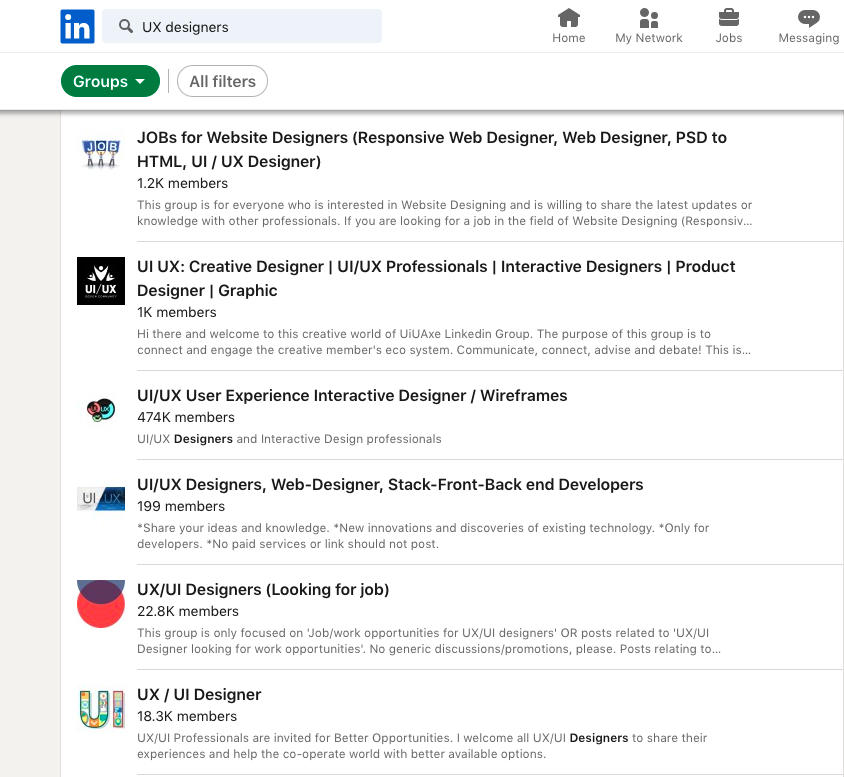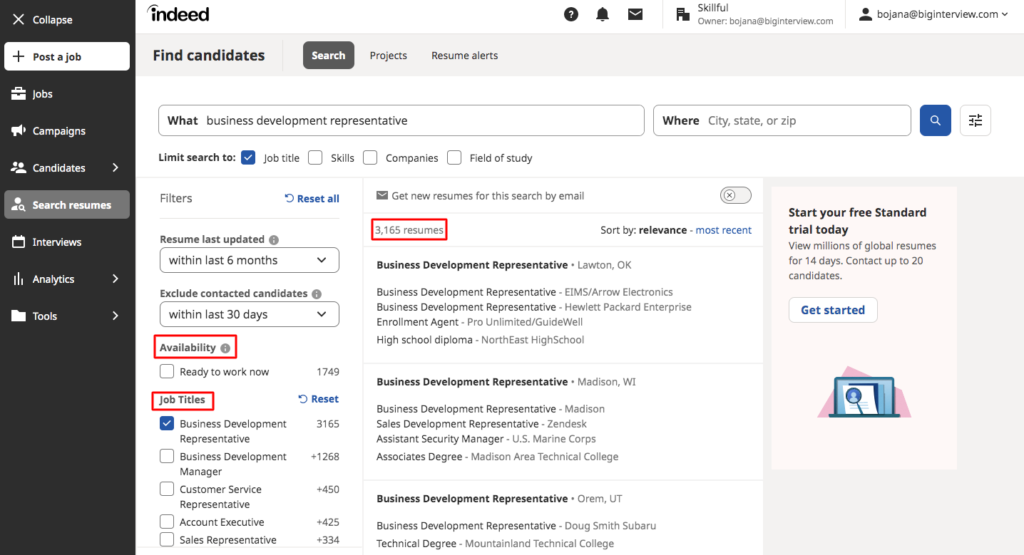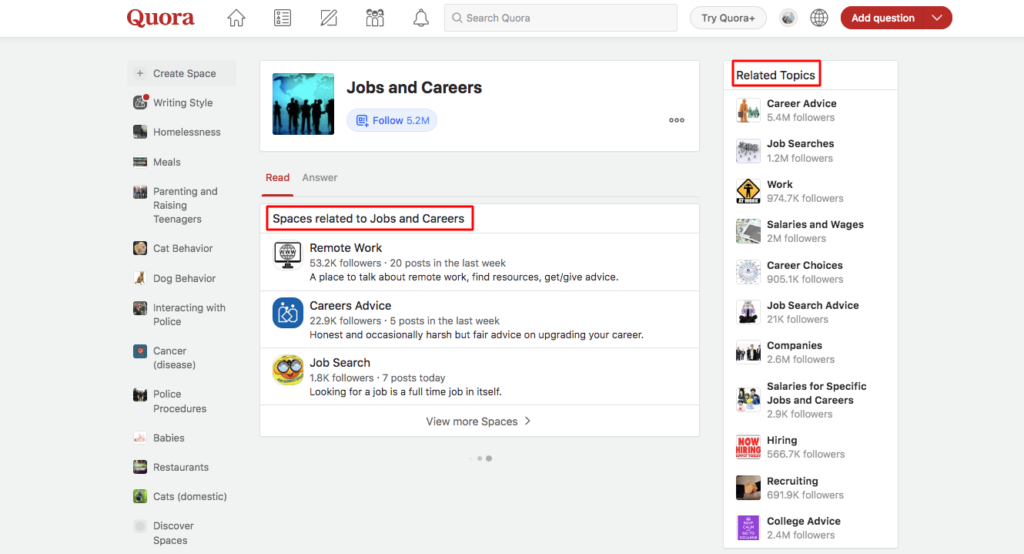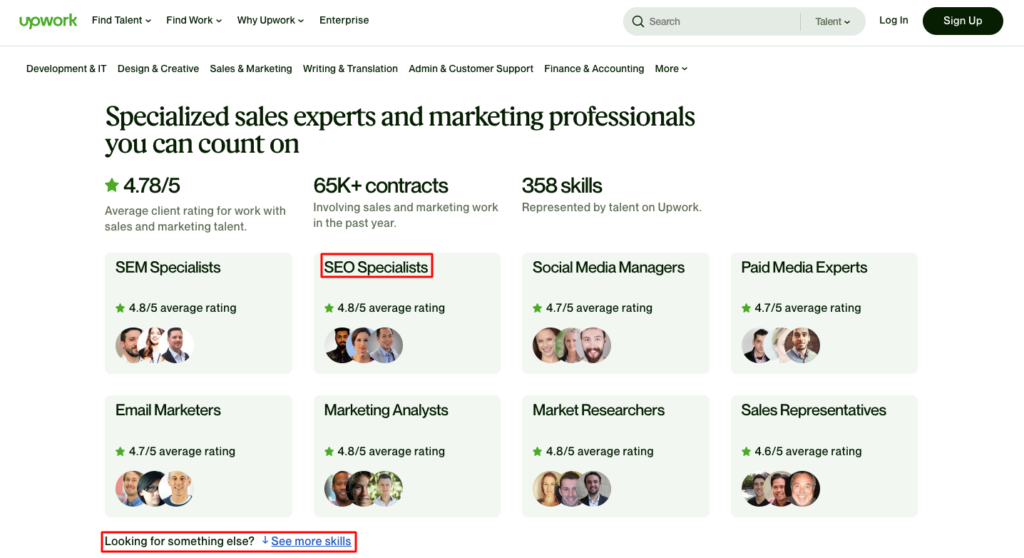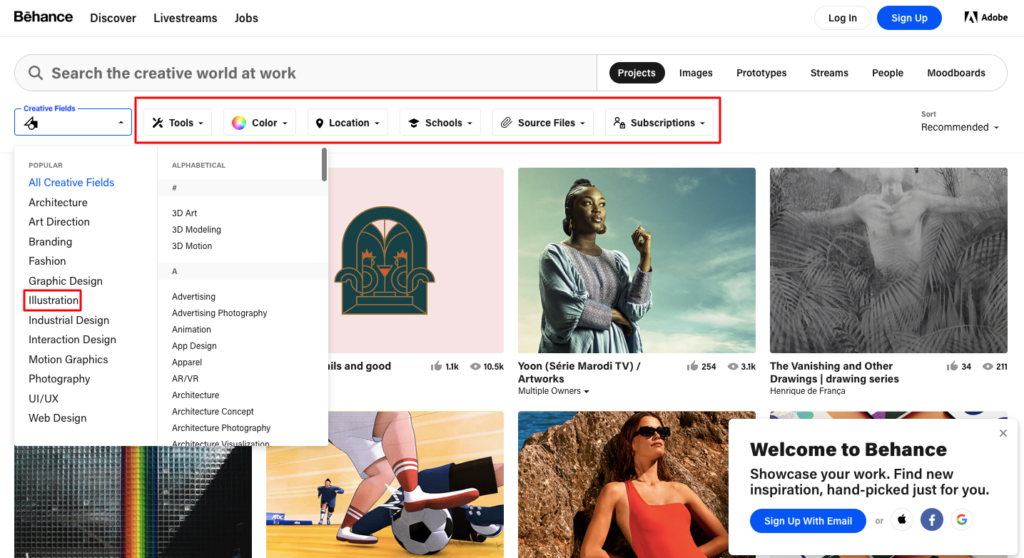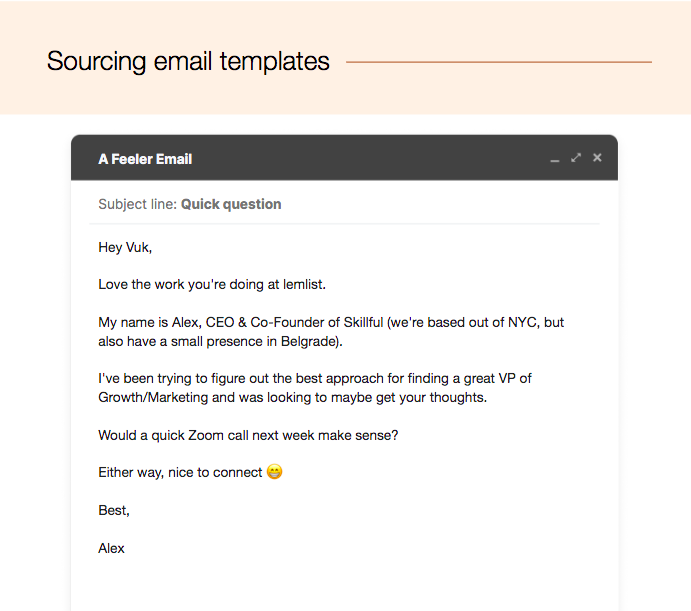Your recruiting sourcing strategy depends on many things – the role you’re exploring, the size of your business, your budget, and human resources.
Although there’s no secret candidate sourcing formula that works for everyone, there are some tested and creative ways to identify and hire top talent that work most of the time.
In this article, you’ll find 10 best sourcing strategies in recruitment, with real-life examples used by TAs and Sourcing Specialists.
Top Challenges in Talent Sourcing
All the TAs we talked to noted a few common hurdles when sourcing candidates:
- It’s difficult to find the right match – Both job requirements and skills have become incredibly diverse. This makes candidate hunting more complex than finding a date on Tinder. Take a look at how specific this job ad for (not your regular) Java Developer is:
So how on Earth do you find a single human with all these skills?- Candidates are often disinterested or unengaged – Even if you find them, they could be perfectly content where they are (relationship status: happily employed). This poses extra challenges for recruiters – How do I make them trust me enough to even let me show them a place where the grass is truly greener?
- The best candidates rarely apply for jobs – Rather, they are discovered and hand-picked by recruiters. These “unicorn hires” are hard to find and recruit, but once in, they bring incredible value and raise the bar for everyone in the company. When changing jobs, they’re more motivated by the challenge and experience than the paycheck and benefits. But where can you find them?
- Most candidates never respond – Ever been sent to Seen City? With a huge shortage of top talent, great candidates receive dozens of job offers daily. Soooo many that they don’t even have the time to go through all the messages, click your links, think about your offer, and finally respond (unless they’re actively looking). This leaves recruiters feeling like they need to put on a dog and pony show just to get the candidate mildly interested.
But it is true – in today’s job market, recruiters need to go the extra mile for their offer to stand out in the sea of others.
And that’s not mission impossible, especially if you have the right recruiting sourcing strategy and tools to back you up.
In this article, we’re sharing some powerful and tested candidate sourcing ideas to help you:
- find more candidates and get more responses,
- spark interest in otherwise passive candidates, and
- secure and hire top talent in an increasingly tight job market.
Finding Talent: Why You Need a Recruiting Sourcing Strategy
In an ideal world, you’ll post a job ad and top-quality candidates’ resumes will start pouring in.
In reality, your HR teams will be actively looking for and discovering the pool of talent for open positions. This process by which recruiters and hiring managers find potential candidates is known as candidate sourcing and is usually the first step in the hiring process.
Candidate sourcing involves several stages – from identifying and researching talent to networking and reaching out – and can be done in-house or through a recruitment company.
Your talent sourcing strategy is the way you decide to approach your outreach with multiple channels and pipelines at your disposal.
In other words, the magic of creative candidate sourcing for recruiters lies in smart and innovative approaches to engage and attract amazing human beings with the right skill set.
And yet, many recruiters are still doing it the old way.
Why You’re Missing the Best Candidates
Although you may be sticking to the basic principles of candidate sourcing, you could still be hitting a wall. From what we’ve seen, recruiters’ lack of success can be blamed on these 4 things.
You’re not custom-tailoring your ads based on role
While it’s okay to have a single general approach to writing job descriptions, it’s also okay to experiment a little. For example, tech startups and Fortune 500 companies will have different job ads for a single role, simply because their employer branding is different.
Still, if you’re a startup hiring a Senior Software Engineer, you may want to approach that job ad differently from when you’re looking for a Marketer – after all, these profiles ARE different.
Engineers may prefer very specific information with little or no fluff and no crazy emoji, latest lingo, and exclamation points. Take a look at how Hotjar makes this Software Engineer ad friendly, yet laser-focused on crucial info:
You’re not targeting passive candidates
Wondering where your best peeps are? There’s a 90% chance they are employed and nowhere near seeing your job ad. If you’re not looking beyond your ATS and the actual applicants, you’re in shallow waters, and your Moby Dick is definitely not there.
You have your ICP wrong
When you learn which position you need to fill, you’re not thinking of the ideal candidate profile – the set of attributes your dream hire should have.
This blueprint is a mix of personality traits, their past experience, work history, and specific hard and soft skills. Combined with the unique requirements of the role and your company culture and identity, the ICP should be at the forefront of your mind at every single stage of the hiring process.
For example, if you’re looking for a writer to handle your blog and website content but you have no dedicated SEO person on board, you need an entirely different profile than when hiring a writer who specializes in email writing and setup.
For the first scenario, you’ll need an independent player who’s confident with tools like GA, GSC, SEMRush, or Ahrefs and who can handle the SEO aspect of the job. For the second scenario, you’ll need someone familiar with emailing best practices and email systems (SEO experience is not needed).
Bottomline – you need to custom-tailor your ICP based on the exact job requirements, which is why you’ll need to work closely with hiring managers and scan for specific strengths.
Get this right and you’re 50% done.
You’re not investing in employer branding
A strong employer brand is a major asset in positioning yourself as an attractive employer and attracting the best talent. And you should treat it as such.
Like all great things in life, it doesn’t happen overnight – so if you’re not already outlining an employer branding strategy, do it. It’ll help you get better applicants and boost retention, increase employee engagement, and build the reputation your company deserves.
Once you’ve plugged these holes, you’re ready to start candidate sourcing. We’re sharing our top recruiting sourcing strategies that have worked for us and our TA friends.
How to Approach Your Candidate Sourcing Strategy Like a Pro
Here are some ideas on talent sourcing that go beyond the job ad.
1. Take the proactive route
You can meet with the hiring managers to discuss typical and potential future positions (especially vital if you’re a fast-growing company), so that you can fast-track the process once they become available. That way you can lay the groundwork in advance.
For instance, if your Marketing team currently has a Marketing Manager, one Content Writer, and one Lead-Gen Specialist, and you’re about to hit new markets or likely to need more people, start thinking about what other roles that will require.
In that scenario, you’ll probably need 2 or 3 more writers with different foreign language expertise, a person to handle multi-language SEO, someone to handle your Google Ads and Display Marketing efforts, a Growth Marketer, and more people to handle your CRM.
Knowing that beforehand will give you more time to explore potential hires and create a richer pipeline.
The easiest way to do that is through continual networking on platforms like LinkedIn. Follow the people whose work you admire and keep widening your network. You can also create a spreadsheet or Trello board with information about them. Once a new position opens, you’ll have a list of your dream candidates ready (That’s exactly how we built the Marketing team here at Skill).
2. Check your existing database
You can also dig into your existing applicant tracking system to check for candidates you’ve already considered before. You may have already met (and forgot about) your dream candidate, but things didn’t work out the first time around.
Your ATS will let you search for keywords that are crucial for the role and match the requirements and skills for the job.
3. Create a talent network on your website
Remember employer branding? Depending on the experience you offer to candidates and employees, your company may be the first choice for many job seekers out there.
Limiting the job ads on your Careers page to only what you need “right here, right now” may lead to missing out on some exceptional candidates.
Our $0.02 – include a “blank ad” or create a Talent Network on your website to allow candidates who admire your company and are dying to join the tribe to submit information, resumes, and cover letters.
Here’s how IBM does it:
This is super easy – a single page with a form where your fans can upload their resumes and provide additional information like contact details, experience level, areas of interest, primary skill set, and geolocation.
In a few months, I bet you that you’ll be using this database to discover amazing talent. Test it out and thank us later.
4. Embrace the power of LinkedIn Recruiter
LinkedIn is the world’s largest professional network, and LinkedIn Recruiter allows you to tap into that network and browse 740+ million members to find people you’d like to have on your team.
LinkedIn has 3 different talent sourcing solutions that can come in handy:
- LinkedIn Recruiter – the best tool if you’re hiring at scale and need to source and manage a larger number of candidates.
- LinkedIn Recruiter Lite – a lightweight sourcing and recruiting platform for low-volume hiring.
- LinkedIn Jobs – allows recruiters to post jobs, get applications straight from LinkedIn, and prioritize and filter only the best candidates.
So how exactly can LinkedIn Recruiter help you with sourcing candidates?
- You can use keyword search, Boolean operators, and 40+ other filters to perform deep searches of the relevant people on LinkedIn, no matter if you’re already connected or not.
- You can view a candidate’s full profile and contact details (including phone numbers, if they provided them).
- You’ll have recommended matches. Those are usually candidates who are open to new work opportunities or who have already interacted with your brand on and outside of LinkedIn.
- You can contact candidates directly through InMail, even if you’re not connected (the limit is 150 InMails/month/team member).
We asked Tanja, a technical recruiter for major EMEA tech companies, to run us through her process:
I practically live in LinkedIn Recruiter. It has helped me source and hire 90% of the most demanding tech roles you can think of – Senior DevOps, DevSecOps, Architects, Cloud Integration and APIs, as well as Devs working in more obscure coding languages. I love how I can narrow down the search and end up with a realistic number of candidates to reach out to.
Here are some of Tanja’s favorite features:
- I find Spotlight to be a very interesting option on LinkedIn Recruiter. I put a few Job Title keywords in the filter field and Spotlight gives me the candidates who are listed as “open to work” or who are most likely to get back to me.
- I can tailor my searches in many different ways. The key piece of advice here is – don’t be afraid to play with the tool until you find your best search strategy. I like to specify the job titles and tech stack, but you can also choose the seniority levels, experience and assessment, skills, and tech stack.
- I love LR because it gives me all the key info at a glance. When I set all my search criteria, I get to see previews of all the candidates that match them, with basic info like their role, current employer, location, education and email address. It’s amazing that you can see how long they’ve been in their role and current company.If I’m looking for a Senior Java Engineer and they’ve just started in their current role or if they have under a year of experience with Java, I won’t be contacting them. On the other hand, I can save all those candidates that have 3+ years of Java experience to a Project, and then get a better look at them later.
- I can email directly from Recruiter! Now this is super useful and saves me tons of time. I normally have a few email templates that I use for first outreach, and what I do is just open the candidate’s profile and if they look like a solid fit, I email them straight from Recruiter. If the candidate is a 1st-degree connection or already a job applicant, I can email them for free, but if they’re a 2nd or 3-rd degree connection, it goes through my InMail credit.If the candidate has an email address saved on their profile, I can choose between sending the message on LinkedIn OR via email.It’s that feature that’s done wonders for me, really. Especially when looking for candidates who are not on LinkedIn daily or with those who get tons of messages from recruiters and don’t even bother to look. With millennials, too. They’re more likely to miss a LinkedIn message than an email.
Tanja’s Pro Tip 1:
Sometimes having too many criteria will restrict your query more than you’d like. A good example is when I enter a seniority level. Candidates (and companies) can be provisional when specifying their seniority. A Senior Java developer may be considered a Mid-level in another company, and I want as few false positives as possible. Or I can easily miss a great Java Developer if their LinkedIn title says simply Back End Developer. Or Java Engineer. Or Java Software Engineer.
Tanja’s Pro Tip 2:
If I need a candidate with a specific skill set or framework and if I know a company that uses it, I will then use that company in my search criteria and get super relevant results!
5. Tap into communities
Let’s say you want to take up hiking but none of your friends and family are into it. You’d have to join a club or find like-minded people elsewhere.
Now apply that logic to business – birds of the same feather flock together. From CEO roundtables, conferences and workshops, to Reddit threads and Facebook groups – there’s sure to be a place that’s your gold mine of best talent in their field.
You just have to find it. Here are a few ideas:
- Facebook Groups – Private Facebook groups, where you need to be approved in order to become a member, give people a sense of exclusivity and the freedom to discuss work a bit more openly.For you as a recruiter, this is an amazing opportunity to get to know experts in a less formal setting than a job ad or LinkedIn and establish a connection more organically. Here are some Facebook groups you could check out:
NodeJS Developers (154.4K members)
React Developers (111K members)
Vue.js Developers (52.9K members)
Computer Programmers (15.3K members)
Software Engineers (10.7K members)
Mobile App Developers (23K members)
UI/UX Designers (208.9K members)
UI/UX Designers and Developers (417K members)
Figma UI/UX Designers (37.9K members)
UI & UX Designers (97.7K members)
Project Management (128K members)
Project Management Professional (PMP) (54.6K members)
Content Marketing Lounge (7.8K members)
Digital Marketing Questions (15K members)
Social Media Managers (51.3K members)
Women in Marketing (57.4K members)
Digital Marketing (20.8K members)
Online Marketing (71K members)
Designers’ Guild (21.4K members)
3D Modeling & Animation (214K members)
Content Writers (100K members)
Web Content Writers (57.7K members)
Content Writers (188.4K members)
Freelance Copywriters and Content Writers (46K members)
Looking for a community of your own? Join this Facebook group where TAs, Talent Sourcing Specialists, and Recruiters can connect and have unfiltered conversations about hiring.
- LinkedIn Groups – Like Facebook, LinkedIn has its own groups where professionals gather to network and find work. Just type your keywords in the global LinkedIn Search and select “Groups”. This is what an example query for “UX designers” looks like:
Pro tip: LinkedIn Group Admins are more selective when approving requests to join, especially if you’re a recruiter or someone who’s likely to sell them something. Check out the group rules and make sure you provide value and engage with the community before you start pitching your company to people.
- Indeed – With 200 million visitors a month, Indeed is an amazing job seeking platform that you can leverage as an employer too. In Indeed for Employers, you can claim a page (and use that to boost your employer brand), post job ads, and also find candidates.The candidate browsing experience on Indeed is similar to Recruiter – you can search through job titles, skills, companies, geolocation and fields of study + a bunch of other search criteria like:– when the candidate last updated their resume
– whether they are available to work or employed
– years of experience
– level of education
– current company etc.The recruiters I talked to all raved about one particular criterion – Job Titles. Unlike Recruiter, Indeed predicts similar and related job titles, which you can select or deselect. This solves the problem of “Maybe there are other relevant candidates, but they have a different job title and I’ll never find them”, and does so in a SINGLE search.Take a look at my example below – I’m looking for a BDR, but I choose to select titles like Business Development Manager, Business Development Specialist, or Sales Development Representative, all of which are relevant.
6. Unlock the power of social sourcing
Alongside Facebook and LinkedIn groups, there are communities on social networks where you can source excellent candidates. Here’s what top sourcers recommend:
- Quora – Quora Spaces is a relatively new, community-oriented feature where people get together to discuss shared interests, work included. A good example is this space devoted to remote work. Browsing Quora Topics can also help you discover the people interested in a particular field.
- Reddit – Often overlooked, Reddit (with its 430 million active monthly users) can be an untapped source of outstanding passive candidates. The beauty of Reddit lies in its forum-like subreddits, where people are extremely engaged in exchanging ideas and posting and discussing content related to the topic of the given subreddit.
A note of caution – the Reddit community is truly one-of-a-kind. The crowd despises spam and doesn’t welcome strangers, which makes candidate sourcing on Reddit far from a quick win. You’ll need to “infiltrate” the community, be an active Redditor yourself, and really bring value to conversations before you start headhunting.
Our TA buddy Tanja spilled some Reddit wisdom:
“I use Reddit mainly to get to know the people working in roles that I’m sourcing. I need to know what they’re about, what makes them tick, what hobbies they like and what kind of discussions they’re having on Reddit. I never just post jobs and pitch open positions to members because I’d get banned instantly. Instead, I focus on interacting with other members, building a personal connection, and eavesdropping on conversations they’re having about work or challenges they encounter.”
She shared some of her favorite communities for you to check out, but don’t stop there:
– r/jobs (931K members)
– r/resumes (582K members)
– r/technology (12.7M members)
– r/careersquestions (895K members)
– r/devops (239K members)
– r/aws (213K members)
– r/digitalmarkting (87.1K members) - Twitter – You can use your Twitter business profile to promote your company, grow your community, and advertise open positions too. Chances are that your potential candidates will be fans of the brand, so you’ll find them among your followers. You can also use Twitter’s advanced search to browse people and find specific tweets.
You can also create a sourcing list on Twitter – your own private list of curated Twitter users that you can build over time. This way, you’ll have an organized list of interesting Twitter profiles to source from. We suggest that you add the candidates that you almost hired, as you may want to consider them for a future role.
Pro tip: Other recruiters may keep their Twitter sourcing lists public, and you can use Boolean search – site:twitter.com lists [ROLE] to pick their brain. - TikTok – TikTok is a booming platform teeming with Gen Z talent waiting to be discovered. Here’s how we approach candidate sourcing on TikTok:
The Discover page is where I’m able to search for hashtags and people. If I type “opentowork”, I’ll get results with people who are either looking for a job or are talking about finding jobs. I can also search through hashtags only – for example, #opentowork has 7.2 million views, and I can click it and view all the videos that have used it. Try other hashtags like #tiktokresumes and #hireme.
You can also advertise a job on TikTok (check out the #tiktokrecruiting and #recruting hashtags for inspo).
Pro tip: With so many sourcing platforms available, you need to be organized and keep your social sourcing efforts neat and tidy. If I were doing this, I’d create a Google Sheet or Notion file where I’d map out my contacts, note where I sourced them from (with links), and note some particular things about them (like interests and accomplishments) which I can later use to personalize my approach.
7. Leverage employee networks and referrals
Nothing beats word of mouth.
Another good idea to attract candidates is through the professional networks of your existing employees. Your top performers certainly know some amazing people – they could be friends, former colleagues, or just inspirational people they follow on LinkedIn. You can offer various employee referral bonuses and incentives to motivate your workforce to join your candidate sourcing plan.
Here are some great incentives you can offer:
- additional days off / extended vacation bonuses
- financial bonus (a flat rate or higher amounts for roles that are harder to fill)
- tickets for events like Formula 1, Broadway shows, concerts etc.
- Amazon gift cards
8. Make use of niche platforms and tools
Despite not being made for recruiting, there are dozens of specialized platforms that top recruiters leverage for creative candidate sourcing. Below is a list that you can use.
General tools and candidate sourcing sites:
LinkedIn X-Ray Search – If you lack the budget for LinkedIn Recruiter, you can try this nifty tool. By entering info like location and skills and using Boolean search parameters, you’ll get super precise results from LinkedIn.
Recruit’em – A single, FREE, ad-free tool that lets you source candidates from platforms like LinkedIn, Dribble, GitHub, Xing, StackOverflow, and Twitter. Plus, there’s also a free job ad optimizer that suggests which keywords to include in your ads (based on candidates’ search data).
OctoHR – A free Google Chrome extension which allows recruiters to source developers from GitHub. You’ll get to find candidates’ contact information and view their levels and fields of expertise. No need to provide your email address, so security is definitely a plus for this one.
Shapr – This should be on your list if you’re a startup or a small business. You can use it for networking (2.5 M users, 60% of which are in the U.S.), as well as for talent sourcing.
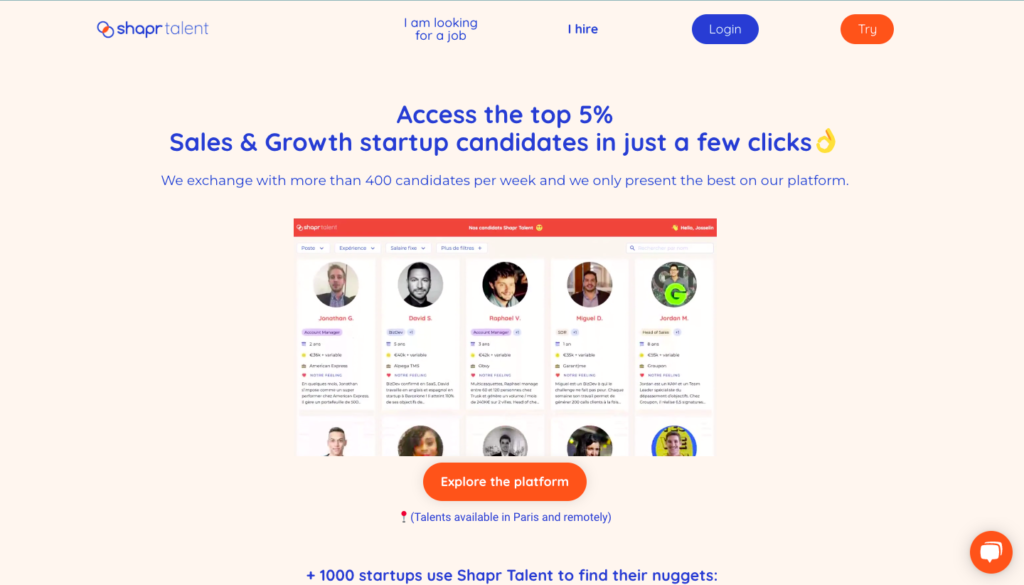
Fiverr – Fiverr is one of the world’s largest marketplaces for digital services. The platform lets recruiters connect with freelancers and filter your search results based on your budget.
Meetup – This is a website which makes it easier to connect with people with similar interests. It lets you browse Events and Groups and it’s great for meeting passive candidates and growing your network through meeting smaller groups of experts over a cup of coffee. Another great initiative for recruiters that doesn’t yield results immediately, but is great for your talent pipeline!
We Work Remotely – WWR is the largest remote work community on the web.
Upwork – Just like Fiverr, Upwork is primarily a place for sourcing freelancers or finding talent for occasional gigs. However, many Upwork gigs have turned into full-time contracts (I landed my first full-time content writing job through a single Upwork task!), so it’s worth giving it a shot.
Let’s say you’re looking to fill a few vacancies in your Marketing team. You could select that particular category and browse subcategories. If I need someone who can do a thorough SEO audit of my website, I could choose the SEO Specialist category or narrow down the search by clicking “See More Results”. There, I could choose the SEO Audit category and browse only talent with that particular experience.
Niche candidate sourcing sites to find specific roles:
GitHub – A great place to find experienced software developers, since GitHub is their go-to place for code hosting and version control. You can check the repositories to see which languages and programs they’re using (even if you can’t tell the difference between programming languages, you’ll get your data there). You can then spend more time on the person and see what projects they’ve been working on recently, whether the code is their own or not.
Medium – A platform to find expert or undiscovered writers, journalists, and storytellers. You’ll find top writers in Medium’s recommendations and on category pages.
Here’s a good starting point:
– The Best Design/UX Writers to Follow on Medium
– The Top 10 Writers You Need to Start Following on Medium
– 50 Writers on Medium with 10K+ Followers
Behance – Behance is the perfect place to source digital artists, designers, and illustrators. Once on the website, you’ll be able to pick the creative field you’re looking for (the categories are alphabetized), the relevant tool(s) like Photoshop, InDesign, Figma etc., and other criteria like the artist’s location (if relevant). You can also use Search to type in your keywords.
Let’s say I’m looking for an illustrator to provide some icons and hero section images for my company website. I’d go to Behance and choose the “Illustration” category to browse some existing work. When I really like something, I’ll go to the artist’s profile and check their full portfolio. Alternatively, there’s also the Jobs section in the top menu, where I could post a job that the candidates active on Behance can find at a single click.
Mogul – Founded by a “30 under 30” woman and trusted by giants like Amazon, Google, Nike, and Loreal, Mogul is a platform that helps businesses hire female and diverse talent thanks to the company’s cutting-edge proprietary search. With 430M available candidates, Mogul can save your sourcing team a bunch of time – you’ll find the best matches, have a rapid ROI and use Mogul’s marketing support to amplify your brand. P.S. 400 of the Fortune 1000 are there.
9. Don’t forget good old email
We said it once and we’ll say it again – email is very much alive. So you can combine email (and InMail) outreach with all other talent sourcing efforts. The key catch here is to make your emails stand out and get read.
To do so, you need to personalize your message to increase engagement and reply rates. Use something you’ve learned about the candidate from their social profiles as a hook to spark conversation.
It can be anything – their hobby and skills, a LinkedIn post of theirs that really resonated with you, or your honest opinion about why they’d be super suitable for the role. Avoid overselling because that’ll only hurt your employer brand and push the candidate away.
Here’s a kickass example of our own:
Lovin it? Email us to get more FREE sourcing email templates (with explanations why they work) that you can copy-paste in one click.
10. Learn Boolean search
Boolean (or X-ray) search is a type of search that combines keywords and operators like AND, OR and NOT to produce extremely relevant results. It can be used with many search engines, including Google.
If you’re a recruiter using Google-lite, typing a phrase like “software developers” in Google will leave you with an unmanageable number of results to go through, most of which will be totally irrelevant. If you use a more precise string like “Java software developers to hire in Austin”, you’ll get only a few results and certainly miss some great people.
With basic knowledge of Boolean operators, you’ll be able to “hack” Google and supercharge your candidate sourcing for free.
Here are some Boolean search basics for recruiters (with examples):
| Boolean operator | When should you use it? | Example |
| AND | Searches for results that include all the keywords linked with AND. | Java AND developer |
| OR | Searches for results that include either keyword or all of them. | developer OR engineer |
| NOT / – (minus symbol) | Searches for results that exclude the keyword preceded by NOT or – *Use – for Google, as it doesn’t recognize NOT. |
-junior |
| “ “ (quotation marks) | Searches for the exact phrase. | “Java developer” |
| site: | Searches for results on a particular website only. | site:twitter.com |
| *(wildcard) | Searches for morphologically related words to give you more results without specifying all the words. | develop* (you’ll get results for “developer”, “development”, “developing” etc.) |
| in:title | Searches for exact matches in page or document titles. | Intitle:resume OR cv |
Here are a few examples of how you can organize your searches to pinpoint relevant candidates using Boolean operators:
- Looking for a UX designer in Seattle on Behance – site:behance “UX design” “seattle”
- Looking for a Boston-based project manager certified for SAP systems – project manage* AND SAP OR “SAP ERP” “boston”
- Looking for an entry-level physio in New York – (intitle:resume OR intitle:cv) “physical therapy assistant” OR “physiotherapist” (New York OR NY) -jobs -example
If you’d like to learn more, here’s a complete list of Boolean operators (made by our brand crush, Ahrefs).
Bonus Tip: Attract Rather than Chase
Finally, a piece of advice that works for all relationships – to attract the right candidates, focus on improving yourself rather than wanting.
To stand out in a competitive market, no matter if your business has 2 or 2,000 people, you’ll need to start from your brand and build your employer image. The best candidates will gravitate towards companies that have a great company culture, employee retention, and brand reputation.
Here’s how your company can start building it now:
- Create an employer branding strategy now
You can control your reputation as an employer by making an effort to make your brand different and recognizable in your niche. It’s not only about how you’re perceived by current employees, customers, or on social media. You also need to look, sound and feel like an attractive place to potential candidates. Employer branding is definitely a process, but it’s also a concrete-like foundation on top of which you can build all your other sourcing and recruiting efforts.
- Build connections with candidates on your website
Wherever a candidate finds you, the first thing they’ll do afterwards is check out your website for more information. For this reason, your ABOUT and CAREERS pages need to be stellar (no pressure!). These pages are your chance to amplify your brand through storytelling and human touch – speak about your values, culture, mission, and vision. Make your employees your main cheerleaders – share employee testimonials (video testimonials are a thing!) or write an article on how you embody your company culture and values.
Final Thoughts on Talent Sourcing
To build and cultivate high-quality talent pipelines and engage passive candidates, it pays off to use a variety of sourcing channels and strategies. You’ll get best results if you:
- diversify your efforts and use multiple platforms, job boards, online communities, and niche websites
- always take the time to personalize your message
- nurture your talent pipeline and candidates you declined in the past for future positions
- use the right combo of candidate sourcing tools to back you up.
Before you go, check out a few other guides that may come in handy when building your candidate sourcing strategy:
Defining Key Competencies Your Job Candidate Should Have

